#The Frisian museum
Explore tagged Tumblr posts
Text
Dorestad Fibula

The Dorestad Fibula (brooch) was found in the Dutch village Wijk bij Duurstede, the successor of the Early Medieval Emporium Dorestad.
Dated between 775-800, this brooch is classified as Frisian. Decorated with gold, garnets from East Asia, pearls, enamel and glass, this brooch belonged to an exceptionally rich merchant.
The brooch depicts the tree of life with leafs and fruits. The green inlay portray stylized bird heads.
RMO Leiden, Netherlands
Object nr. F1978/1.1,
Found in Wijk bij Duurstede-Utrecht, Netherlands.
#archaeology#museum#field archaeologist#field archaeology#Dorestad#emporium#emporia#Netherlands#Dutch#Germanic#Viking#Frisian#Frisia#Merovingian#Frankish#charlemagne#Merovingian archaeology#Viking archaeology#Viking mythology#tree of life
213 notes
·
View notes
Text

Gold pendant with depiction of Romulus and Remus with Anglo-Frisian runes translated as "howling she wolf" and "reward to a relative". Uncovered in Kent, England, 5th century AD
from The British Museum
300 notes
·
View notes
Text





Friesland (2) (3) (4) (5) by Rob Oo
Via Flickr:
(1) Poutsma Staete, Wierum. Large and striking in the middle of the flat and empty Frisian Wadden coast. (2) Blokhuispoort, Leeuwarden. Design: J.F. Metzelaar en W.C. Metzelaar (1870), who also designed the Arnhem and Haarlem panipticon-style prisons, elsewhere in my photostream. Modified many times since, now it is a complex with a museum, hotel, bar, restaurant, creative atelier spaces etc. The point of the door is beyond me. (4) Laundry day at these old fishermen's houses. (5) Een Surinaams huisje op een klein Fries Eilandje. / A Surinamese house on a small Frisian Island.
#houses#countryside#landscape#buildings#doors#laundry#coastal#island#the netherlands#friesland#frisia
10 notes
·
View notes
Text
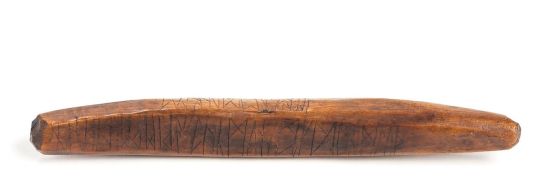
It's great to be able to show that runes were being carved in the Netherlands. This is one of the 23 currently known Frisian rune findings: the Westeremden (a location in the North-East of the Netherlands) yew stick, found in 1918 and dated 5th-8th century. It can be seen in the Groninger Museum.
Made of Yew (Dutch: Taxus, or IJf) which is not a tree that generally could be found in this area. The inscription reads like a blessing or spell for luck/happiness. To me, this is Frisian galðr:
ophæmujiBAdaæmluþ wimœBæhþuSA iwioKuPdunale:
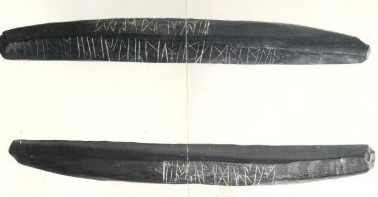

(Source: de Gruyter.)
Elmar Seebold (in 1990) reads:
ophæmu givëda æmluþ: iwi ok upduna (a)le wimôv æh þusë
Tineke Looijenga (in 1997) reads:
op hæmu jibada æmluþ : iwi ok up duna (a)le wimœd æh þusa
(Source) Interpreted as something like:
luck (amluþ) stays (gibada) at home (op hæmu); and (ok) at the yew (iwi) may it grow (ale) on the hill (up duna); Wimœd has (æh) this (þusa)
Modern Frisians translate it into:
op de boerderij (heem) blijft voorspoed; laat het groeien bij de ijf (taxus) op de terp; dit is (eigendom) van Wimoed (Source.)
Interestingly, this 5th-8th century Frisian Futhorc differs slightly from the more commonly known elder Futhark. (Context: the Elder Futhark in the Scandinavian areas transitioned towards the Younger Futhark in the 7th-8th century).
Here are a few interpretations by different writers:

By Parsons.

By Grimmsma.

By Terpen en Wierdenland.
#frisian futhorc#rune#yew#Amulet#galðr#groningen#netherlands#futhorc#5th century#6th century#7th century#8th century#northern iron age#Frisia#dutch
37 notes
·
View notes
Text

Phallic figurines in the Fries Museum, The Netherlands. The sign reads: “Are these two-eyed phallic figurines meant to promote fertility as a fertility symbol? Or are they simply decorative earthenware dolls? We don't know for sure. They were probably imported from present-day Germany, where many workshops made these kinds of dolls.
1250-1500, found in Hantumhuizen, pottery Fries Museum, Leeuwarden | collection of the Royal Frisian Society”
4 notes
·
View notes
Note
if you could participate in any historical event, which one would you pick?
To be honest, as much as I'd like to decapitate a french monarch, or as funny as it'd be to watch several popes argue about which pope is the most pope and which ones are fake popes, as much as I'd love to be a sailor in the earliest days of the Golden Age Of Piracy, I've only really got one answer.
To be 100% honest, ever since I was in high school I've been absolutely enthralled with legendary farmer-turned freedom fighter-turned-pirate Pier Gerlofs Donia, A legendary dude said to be incredibly tall and insanely strong, inseparable from his massive greatsword that was like 7 feet long, 14 pounds, and currently resting in a Frisian museum
Known for being an absolute legend, having the title of The Giant of Kimswerd, starting a long series of battles with the Hapsburgs both on land and at sea, organizing multiple peasant rebellions on land and allegedly sinking 132 ships in his first two years at sea, 28 of which were in a single day. He's also said to have captured like 2/3rds of a dutch fleet maybe? idk
He was also apparently so strong he could bend a coin between his thumb and forefinger, for whatever that's worth? idk I don't know how strong Frisian coins are but I'm glad his strength is on par with Stone Free lmao
While I know most of his life is shrouded in legend with sparse proper documented sources to draw from, I'd love to like, just shadow this dude's life out of curiosity to see exactly how much of his story is exaggerated for the sake of making a cooler legend, vs how much of it is like, real historical things that actually happened
Though I also can't speak Frisian, so given another part of his legend, idk if that'd turn out all too well for me lmao
#One of his legends say that could decapitate 7 men with one swing of his fuckhuge sword#idk how you'd line up 7 dudes like that but I'd love to see if he actually could#or even if he had that sword at all#Given the sword that is ostensibly his appears to be German in origin#though there is a theory that he'd stolen it from a Saxon soldier which imo lines up with his general Vibe#as a farmer-turned-rebel-turned-pirate#before his eventual retirement and surprisingly peaceful passing in his bed#Thanks!#asks#anon
7 notes
·
View notes
Text
Heritage Germany Tourist Attractions to Explore
Are you in the process of choosing your next vacation destination? While checking out the ticket availability of the first class ticket to Accra from UK or any European destination from your London home for a short but impactful tour to witness the rich heritages the Germany should you on your list.
Despite finding multiple options to reach Germany by road, opting for a flight can save you time and energy. Have a talk with your travel agency about the flight offers and the hotel accommodations months before you decide to travel there. However, the off-season deals might also drive you to explore the exotic beauty of Germany in the serenity. Also, keep doors open to get hotter deals from aggregator sites like the Business Flight Shop from where you might have explored the availability and deals on the first class ticket to Cancun from UK some time back!
Top attractions in Germany draw the attention of innumerable tourists from the corners of the world. Thus, they add Germany, one of the largest countries in central Europe while stepping ahead for a European vacation to witness the majestic geographical and manmade creations besides knowing about the history they hold during the World Wars and before that. Being one of the major economic powers of the world, Germany holds a significant position for its culture and rich heritage.
You can have a happening vacation in Germany from exploring the enchanting landscapes to the mouth-watery gourmets even if you miss the famous Oktober fest. So, before planning for your vacation in the Middle East, purchase a first class ticket to Doha from UK– enjoy your summer in Germany instead!
Let’s have a look at some of the top heritage vacation destinations in Germany:
Berlin
Berlin is the present capital of Germany and houses some of the top heritage sights of this country. Ranging from archaic monuments to technology parks, these are must-visit destinations of this country. The best sightseeings comprise– Berlin Cathedral, Deutscher Bundestag, Brandenburg Gate, Memorial of the Berlin Wall, Tranenpalast – Palace of Tears, Tierpark, Classic Remise Berlin, Pergamon Museum, Topography of Terror, Friedrichstadt-Palast, Museumsinsel, Flughafen Tempelhof Museum fur Naturkunde, The Holocaust Memorial, Berlin Philharmonic, Gendarmenmarkt, Deutsches Historisches Museum, Neues Museum, Potsdam’s Gardens, Hohenschoenhausen Prison, German Museum of Technology Berlin, Gedenkstaette Deutscher Widerstand, and so on.
Munich
Located by River Isar, the historic Munich is now the Bavarian capital, which is located in the northern region of the Bavarian Alps. This place is included as one of the must-see destinations of this country. Besides rich history, this city houses great monuments; those are considered heritage sights of Munich. The Residenz Royal Palace, Nymphenburg Palace, Karl’s Gate Asam’s Church, Theatinerkirche St. Kajetan Munich Residence, Glockenspiel am Rathausturm, Starnberger See, St. Peter’s Church, Old Town Hall, Munich Botanischer Garten, Lenbach House, Generals’ Hall, Maximillianstrasse, Nymphenburg Palace, Hackerhaus, BMW Museum, Marienplatz, Old Pinakothek, and so on are among the top German tourist attractions in Munich. Moreover, the Oktoberfest of Munich is famous for its Bavarian Beer.
The Frisian Islands
The Frisian Islands attract huge numbers of visitors and are considered one of the best tourist attractions in Germany. This destination is an island, which is bestowed with some of the excellent landscapes. This heavenly island of Germany is surrounded by the Netherlands and Denmark. The two major islands of Frisian Islands are Sylt and Amrum. The yellow serene beaches, as well as the captivating scenic beauties, are perfect honeymoon destinations for the newlyweds. The best of the natural treasures of this country can be found in these islands and therefore, considered as one of the best German tourist attractions.
The Black Forest
Another German destination of natural excellence is the Black Forest region. This German destination is famous for its famous cuckoo clocks, acclaimed throughout the globe. Besides, this place is a perfect spot for honeymooners, who love spending quality time with each other. Some travellers love to explore adventurous sports like skiing and hiking. Camping is an integral part of the German Black Forest region.
Opt for a packaged tour to Germany from an OTA where you can also add the round-way first class ticket to Entebbe or any destination you are from. By doing so, you have a strategically designed itinerary for saving both money and time.
0 notes
Photo
Richard Brakenburgh or Brakenburg (22 May 1650, in Haarlem – 28 December 1702, in Haarlem), was a Dutch Golden Age painter.
According to Arnold Houbraken he was a light-hearted poet from Haarlem. He was the pupil of Hendrik Mommers who went on to paint clever genre scenes in the manner of Adriaen van Ostade. Though some said he was the pupil of Bernard Schendel, they were the same age and painted in similar styles. He was successful enough at his art that his Frisian widow was able to purchase an annuity after his death in Friesland.
According to the RKD he is registered in Leeuwarden during the years 1670–1687. He is known for both Italianate landscapes and portraits. He painted similar subjects to those of Schendel, representing merry-makings and drunken assemblies. His pictures are ingeniously composed, and well coloured, something in the manner of Adriaen van Ostade, though greatly inferior. They are painted with facility, although they have the appearance of being very highly finished; and he perfectly understood the management of chiaroscuro. His greatest defect is his incorrect drawing of the figure, which he appears not to have studied from nature. The Vienna Gallery has two 'Peasant Scenes' by him, said to have been painted in 1690; the Berlin Museum one, and the Amsterdam Gallery one. In the Brussels Gallery is a 'Children's Feast,' signed and dated 1698; and the Rotterdam Museum has a 'Doctor's Visit,' signed and dated 1696. In Windsor Castle are two good 'Artists' Studios ' by him. He also sometimes practised the art of engraving.
He was the teacher of Wigerus Vitringa, Abraham Pardanus, and Gillis de Winter. He was a follower of Jan Steen. He died at Haarlem in December 1702 and was buried in January 1703.

Richard Brakenburgh - Celebration of a Birth
1683
oil on panel
Dulwich Picture Gallery, London
41 notes
·
View notes
Text
Pella, Iowa the beautiful!
Pella, Iowa the beautiful!
I have always wanted to go to Pella, Iowa! After seeing pictures of the beautiful Vermeer Mill, I was smitten. This June 2021, was my summer for an amazing hosted Pella, Experience! Let me tell you all about Beautiful Pella and what you can do in this Southcentral Iowa town! In front of Visit Pella with Jill Vandevoort. The first part of our journey was to Pella. Jill Vandevoort of Visit Pella…

View On WordPress
#Brenda Kelderman#Cheesemaker&039;s Inn B&B#City of Refuge#Dutch cooking#Dutch history#Frisian Farms Cheese House#Gary Vermeer#Henrik Scholte#Historical Museum/Vermeer Windmill#Jill Vandevoort#Klokkenspel#Liberty Street Grill#Mahska County Iowa#Molengracht Plaza#Nana&039;s TableCafe#Oskaloosa Main Street#Pella#Pella Iowa#Pella Tulip Festival#Sawyer Phillips#Scholte House Museum#Southcentral Iowa#Sprint car racing#sundial#Thursday Nights in Pella#Tulip Toren#Vermeer Global Pavilion#Vermeer Mill#Visit Pella#Wyatt Earp Experience
3 notes
·
View notes
Photo

Tames Oud - A Horse-Drawn Cart in the Snow
14 notes
·
View notes
Photo

August Schaeffer von Wienwald - Motive from Helgoland - 1859
oil on canvas, height: 50 cm (19.6 in); width: 63 cm (24.8 in)
Heligoland (German: Helgoland, ) is a small archipelago in the North Sea. A part of the German state of Schleswig-Holstein since 1890, the islands were historically possessions of Denmark, then became the possessions of the United Kingdom from 1807 to 1890, and briefly managed as a war prize from 1945 to 1952.
The islands are located in the Heligoland Bight (part of the German Bight) in the southeastern corner of the North Sea and had a population of 1,127 at the end of 2016. They are the only German islands not in the vicinity of the mainland. They lie approximately 69 kilometres (43 miles) by sea from Cuxhaven at the mouth of the River Elbe. During a visit to the islands, August Heinrich Hoffmann von Fallersleben wrote the lyrics to "Deutschlandlied", which became the national anthem of Germany.
In addition to German, the local population, who are ethnic Frisians, speak the Heligolandic dialect of the North Frisian language called Halunder.
August Schaeffer von Wienwald (30 April 1833, Vienna - 29 November 1916, Vienna) was an Austrian landscape painter and Director of the Kunsthistorisches Museum.
22 notes
·
View notes
Text
Loom weights

Loom weights are almost always found in woman’s graves. They are made in various shapes and sizes, f.e. round, teardrop shaped or triangular.
Made from ceramics, bone or carved stones, loom weights provide tension which enables to weave evenly. Despite there being multiple weights on a loom, they’re never given as grave goods in complete sets.
The possible reason only a few or just one weight is given is perhaps to underline the woman’s talent and skills at weaving.
Textiles in the early medieval era were most often made from wool or flax. Frisia was famous for its high quality wools. This was because of it’s central location, the unique landscape which doesn’t allow to be farmed, but is fertile and high in nutrients for grazing sheep, combined with excellent weaving quality and the selling of semi-finished products. The production and trade of wool enabled the Frisians to grow very wealthy.
Koninklijk Museum voor Kunst en Geschiedenis (KMKG), Brussels (city) - Brussels Capital Region, Belgium
Museum nr. B002118-001
Found in Labuissière (Merbes-Le-Chateauh, Hainaut - Belgium
#frankish#merovingian#viking archaeology#archaeology#carolingian#charlemagne#field archaeology#viking mythology#merovingian archaeology#germanic mythology#norse mythology#anglo saxon#field archaeologist#frisian#odin#viking#vikings#germanic#germanic folklore#germanic archaeology#wodan#anglo saxon archaeology#history#jewelry#norse#card weaving#textile history
41 notes
·
View notes
Text
I'm reaching that point where I'm just. tired. and want to lie down all day
but I cannot have come all the way to the Netherlands and not visit the Rijksmuseum. so I'm considering maybe skipping Ljouwert... I really would've loved to visit the AFûK and Frisian Museum but I feel like I have to choose between Amsterdam and Friesland. Or I can power through it as rest when I get home
15 notes
·
View notes
Photo

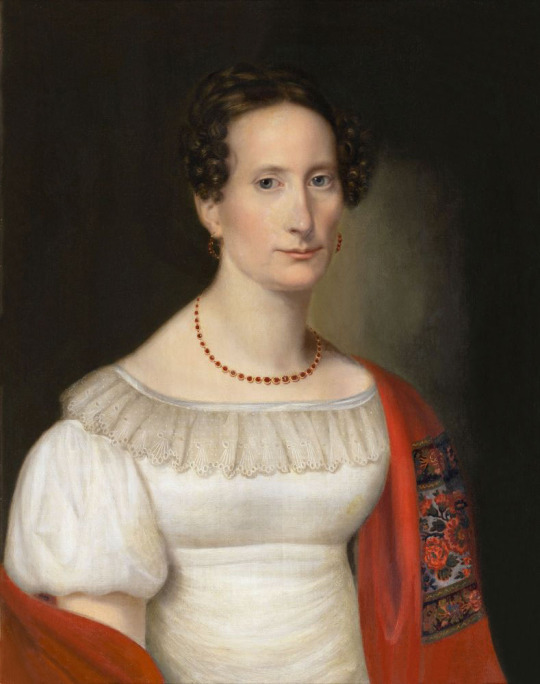
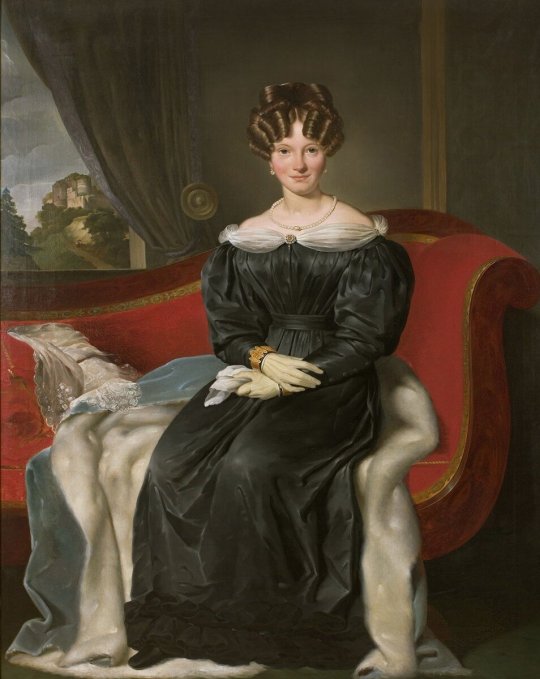

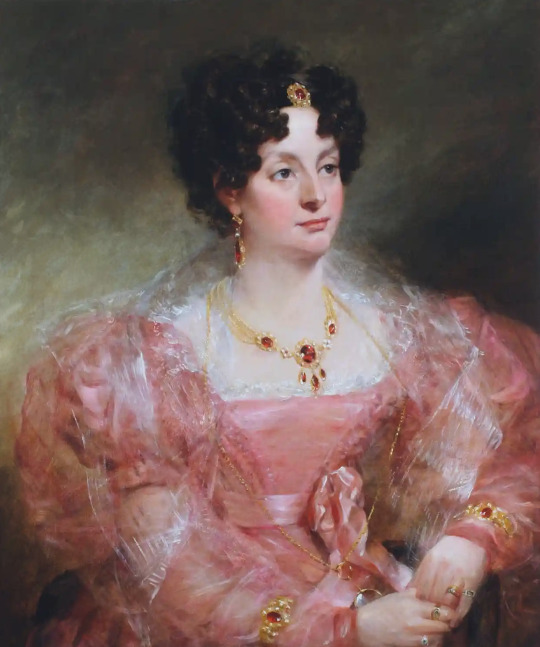




1820s dresses (from top to bottom):
1820 Bella og Hanna. M.L. Nathansons ældste døtre by Christoffer Wilhelm Eckersberg (location ?). From tumblr.com/blog/view/fashionsfromthepast 1769X2607 @72 1.2Mj.
1820 Lady by Wilhelm Gottfried Bauer (Aiktionhaus Stahl - 7May22auction Lot 386). Removed spots w Photoshop 789X1000 @72 147kj.
1826 Antoinetta Margaretha Brasker by Jan Adam Kruseman (Fries Scheepvaart Museum/Frisian Maritime Museum - Sneek, Friesland, Netherlands). From kovlam.livejournal.com/1275171.html 954X1199 @100 270kj,
ca. 1825 Anne Bloham by Sir Thomas Lawrence (location ?). From pinterest.com/aeltukov/art/gb-regency-era-1793-1837/; cropped to remove previous frame intrusions 1242X1511 @72 600kj.
ca. 1826 Emily Treslove by John Constable (private collection). From theguardian.com/artanddesign/2021/sep/18/new-constable-portrait-artist-painting-emily-treslove-artist-neighbour-double-chin; removed spots & flaws w Photoshop 2247X2691 @144 4.8Mp.
Herzogin Mathilde von Württemberg mit ihren beiden Kindern by Carl Rothe (Neumeister 30Mar22 auction Lot 1444). Removed spots, cracks & wrinkles with Photoshop 3369X4016 @300 2.2Mj.
Herzogin Sophie Dorothee Caroline von Württemberg by Franz Seraph Stirnbrand (Neumeister 30Mar22 auction Lot 1437). Removed more conspicuous cracks, wrinkles, & flaws with Photoshop and cropped 3309X3939 @300 2.4Mj.
Unknown woman wearing a blue-striped bodice by Louis Léopold Boilly (Christie's - 30Oct18 auction Lot 55). Removed spots & cracks with Photoshop 1497X2028 @144 3.2Mp.
1829 Surgeon Christian Fenger with wife and daughter by Martinus Rørbye (Ribe Kunstmuseum - Ribe, Jylland, Denmark). From tumblr.com/blog/view/history-of-fashion/679957013176975360 2048X2483 @72 1.4Mj.
#1820s fashion#French restoration fashion#Eckersberg#Christoffer Wilhelm Eckersberg#straight and braised hair#chemise#high neckline#full under-sleeves#quarter-length under-sleeves#cap over-sleeves#V waistline#Empire waistline#A-line skirt#lace fringe#lace-trim#wrap#shoes#1820 fashion#Wilhelm Gottfried Bauer#bateau neckline#lace bertha#quarter-length flared sleeves#1826 fashion#Jan Adam Kruseman#Kruseman#curled hair#bun#fan-front bodice#sheer bertha#off shoulder neckline
19 notes
·
View notes
Photo








⚔️ The zweihänder sword and helmet (presumably) belonged to Pier Gerlofs Donia (1480-1520), otherwise known as Grutte Pier (Greate Pier), Friesian pirate, warlord and folk hero of the late 15th century who sunk 132 enemy ship – including one battle where he destroyed 28 Dutch ships in a single day.
📝 The sword measures: Length - 2.13 m (7 ft) Weighs - about 6.6 kg (14.6 lb)
The Blade has the stamp “Inri” (Jesus of Nazareth, King of the Jews) The handle is made of oak and covered with goat skin in one piece, taken from the leg, that is, there is no seam. In all likelihood, this sword with identifying marks, came from Germany. The sword is on display in the Museum of Friesland (Fries Museum) in Leeuwarden. Collection Fries Museum Inv. Nr. H 185-C
Interesting facts: 📜 In 1515, Pier Gerlofs Donia's house was destroyed and burned by soldiers of George the Bearded (Georg der Bärtige, 1471-1539), Duke of Saxony, founder of the Albertine branch of the Wettin family. The Landsknechts raped and murdered Pierre's wife, after which hatred prompted him to take part in the Guelders Wars (Dutch: Gelderse Oorlogen) against the powerful Habsburgs, on the side of the Duke of Guelders, Charles II (1492-1538), a member of the House of Egmond.
📜 According to legend, Pier was around 7 feet (around 2.13 m) tall, and was so strong that he could bend a coin using just his thumb and forefinger.
📜 Another legend attesting to his great strength is that he was able to pick up a plough with just one hand.
📜 There is another legend that says that Greate Pier could cut down several heads with his sword at once.
- - ⚔️ Этот меч и шлем (предположительно) принадлежали фризскому пирату, военачальнику и народному герою конца XV века Пьеру Герлофсу Дониа (1480-1520), известному как "Большой Пьер" (Grutte Pier), потопившего 132 вражеских корабля, включая одно сражение, в котором он уничтожил 28 голландских кораблей за один день.
⚔️ Размеры меча: Длина - 2,13 м Вес - около 6,6 кг Произведен в Пассау, Германия, сер. XV в. Рукоятка изготовлена из древесины дуба и покрыта цельным куском козьей кожи, взятой с ноги, то есть нет шва. Клинок имеет клеймо "Inri" (Иисус из Назарета, Царь Иудейский). Меч выставлен в Музее Фризии (Fries Museum) в Леувардене.
Интересные факты: 📜 В 1515 году дом Пьера Герлофса Дониа был разрушен и сожжён солдатами саксонского герцога Георга Бородатого (Georg der Bärtige, 1471–1539) из династии Альбертинов. Ландскнехты изнасиловали и убили его жену, после чего ненависть побудила его принять участие в Гельдернской войне против могущественных Габсбургов, на стороне гельдернского герцога Карла II (1492—1538) из династии Эгмонтов.
📜 Согласно легенде, "Большой Пьер" был ростом около 2,13 м и был настолько физически силен, что мог согнуть монету, зажав ее между большим и указательным пальцами. А также поднять плуг только одной рукой.
📜 Еще одна легенда гласит, что Пьер мог срубить своим мечом сразу несколько голов.
1K notes
·
View notes
Photo

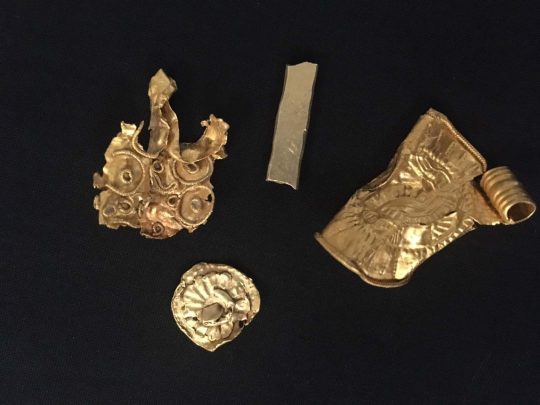
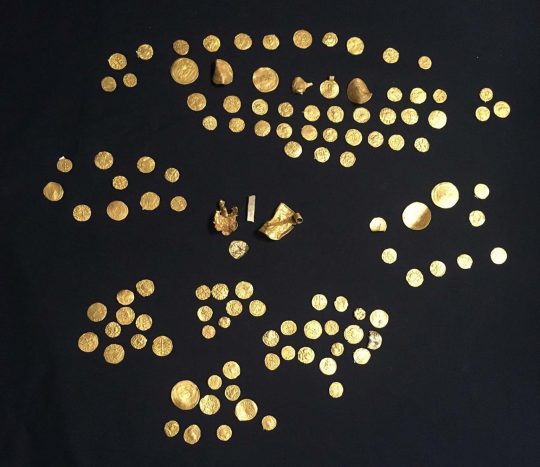
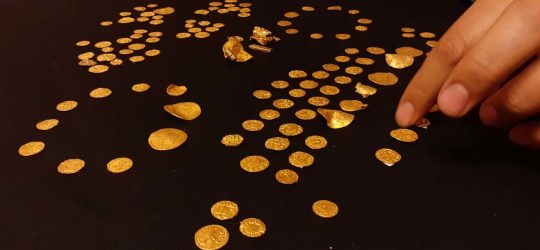
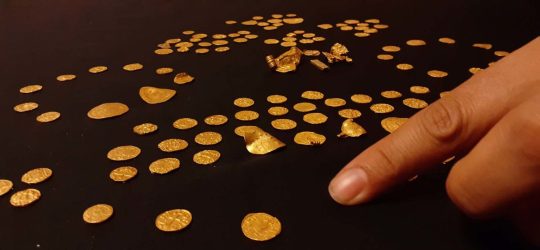


England’s Largest Anglo Saxon Gold Coin Hoard Found
Norwich Castle Museum hopes to acquire the largest Anglo Saxon gold coin hoard ever found in England
The largest find to date of gold coins from the Anglo-Saxon period in England has been revealed after it was unearthed by metal detectorists in a field in West Norfolk.
Buried shortly after AD 600, the West Norfolk hoard contains a total of 131 gold coins, most of which are Frankish tremisses, solid gold coins from the Frankish Kingdoms of Gaul and Western Europe, which were not yet produced in East Anglia at the time.
The hoard also contains nine gold solidi, a larger coin from the Byzantine empire worth three tremisses and four other gold objects, including a gold bracteate (a type of stamped pendant), a small gold bar, and two other pieces of gold which were probably parts of larger items of jewelry.
It is thought the presence of these items suggests that the coins should be seen as bullion, valued by weight rather than face value. Experts say the haord will help transform our understanding of the economy of early Anglo-Saxon England.
“This internationally-significant find reflects the wealth and Continental connections enjoyed by the early Kingdom of East Anglia,” says Tim Pestell, Senior curator of Archaeology at Norwich Castle Museum, which hopes to acquire the find.
“Study of the hoard and its find spot has the potential to unlock our understanding of early trade and exchange systems and the importance of west Norfolk to East Anglia’s ruling kings in the seventh century.”
East Anglia is famed for its Anglo Saxon heritage, but the previous largest hoard of coins of this period was a purse containing 101 coins discovered at Crondall in Hampshire in 1828. It had been disturbed before discovery and may originally have included more coins. Buried around AD 640, the hoard contained a mixture of Anglo-Saxon, Frankish and Frisian coins, along with a single coin of the Byzantine Empire, minted in Constantinople.
Archaeologists now regard this period ��� the decades on either side of AD 600 – as quite literally a ‘golden age’ for Anglo-Saxon England. The largest find of gold metalwork from the era is the spectacular mid-7th century Staffordshire hoard, discovered in 2009 by Terry Herbert and comprising over 5.1kg of gold and 1.4kg of silver. But it contains no coins.
Back in East Anglia, the famous ship burial from Sutton Hoo in Suffolk, which dates somewhere between AD 610 and 640, includes a purse of 37 gold coins, three blank gold discs of the same size as the West Norfolk coins and two small gold ingots, as well as many other gold items.
The Sutton Hoo purse contained only Frankish coins, reflecting the fact that although imported coins were already used in East Anglia by this time, they were not yet being minted in the area by the time of the burial.
Another important Anglo Saxon grave was discovered in 2003 at Prittlewell in Essex, probably buried a few years before the Sutton Hoo ship, and yielded two gold coins and other gold objects.
The majority of the objects in the latest hoard were found between 2014 and 2020 by a single detectorist, who together with the landowner has requested anonymity, hence the find currently being described only as coming from ‘West Norfolk’.
A Coroner’s inquest is currently being held to determine whether the find constitutes Treasure under the terms of the Treasure Act (1996). If any two or more coins contain more than 10% of precious metal and are confirmed by experts to be more than 300 years old, they will be declared Treasure and will be the property of the Crown. Typically, the government only claims the find if an accredited museum wishes to acquire it, and is in a position to pay a reward equivalent to the full market value.
In this case the anonymous finder reported all of his finds to the appropriate authorities. However, ten of the coins were found by a second detectorist, David Cockle, who had permission from the landowner to detect in the same field.
Mr Cockle, who at the time was a serving policeman, failed to report his discovery and instead attempted to sell his coins, pretending that they were single finds from a number of different sites. Mr Cockle’s deception was uncovered, and in 2017 he was found guilty of theft and sentenced to 16 months in prison, as well as being dismissed from the police.
“The West Norfolk hoard is a really remarkable find, which will provide a fascinating counterpart to Sutton Hoo at the other end of the kingdom of East Anglia,” says Helen Geake, Finds Liaison Officer for Norfolk.
“It underlines the value of metal-detected evidence in helping reconstruct the earliest history of England, but also shows how vulnerable these objects are to irresponsible collectors and the antiquities trade.”
The administration of the Treasure process is undertaken at the British Museum who also manage the Portable Antiquities Scheme (PAS) in England (in Wales it comes under the management of Amgueddfa Cymru – National Museum Wales).
Thousands of archaeological objects, many of them found by members of the public, are logged every year with the Finds Liaison Officers of the PAS to improve our understanding of the past. They can be explored at www.finds.org.uk
By Richard Moss.
#England’s Largest Anglo Saxon Gold Coin Hoard Found#archeology#metal detector#history#history news#ancient civilizations#treasure#gold#gold coins#collectable coins#jewelry
21 notes
·
View notes